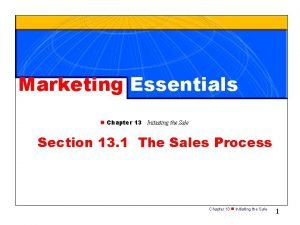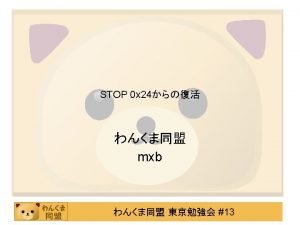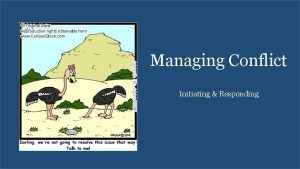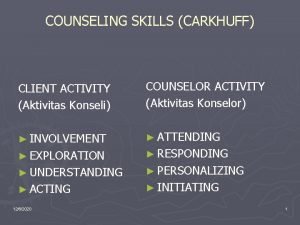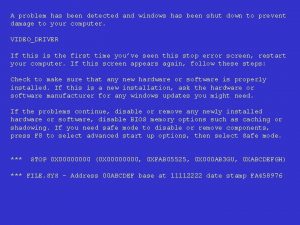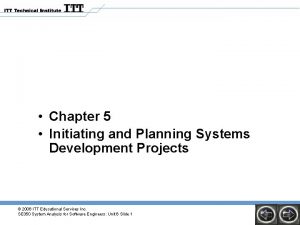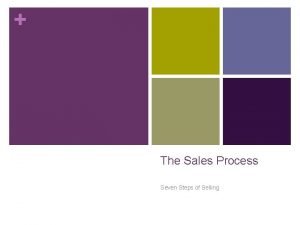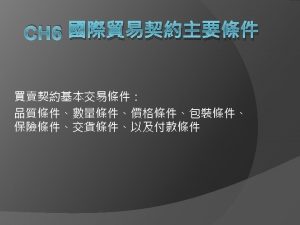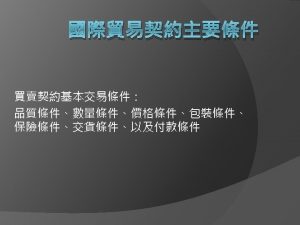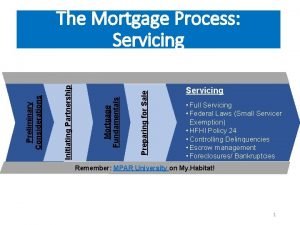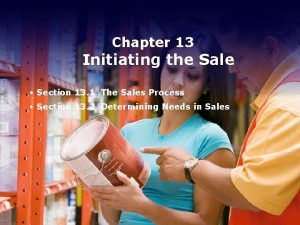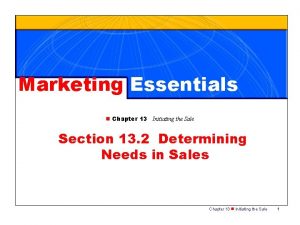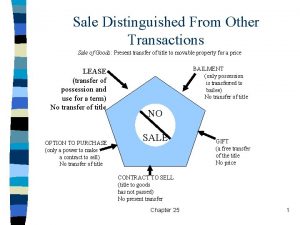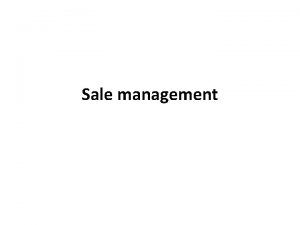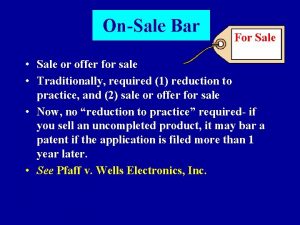Ch 13 Initiating The Sale The 7 Steps





































- Slides: 37

Ch. 13 Initiating The Sale

The 7 Steps of a Sale 1. Approaching the Customer – 2. Determining Needs – Learn 3. Presenting the Product – Greet customer face-to-face what customer is looking for Educate customer about the product

The Steps of a Sale (Cont. ) 4. Overcoming Objections ü Learn why customer is reluctant to buy ü Provide info to remove uncertainty ü Help customer make satisfying buying decision 5. Closing the Sale – Get customer’s agreement to buy

The Steps of a Sale (Cont. ) 6. Suggestion Selling – Suggest that 7. Relationship Building – Create ways the customer buy additional merchandise or services to maintain contact after purchase

Remembering the 7 Steps Approach Customer Needs Determined Product Presentation Objections Handling Closing the Sale Suggestion Selling Relationship Building

Approaching the Customer n First face-to-face contact n Critical first few minutes n Sets mood for the sale n Approach has 3 purposes: 1. Begin conversation 2. Establish relationship 3. Focus on the product

Approaching the Customer (Cont. ) 1. Begin Conversation – Be alert to customer’s interest – B 2 B: Doing homework/research – Retail: Be observant from moment the customer enters store

Approaching the Customer (Cont. ) 2. Establish relationship – Treat customer as individual – Be alert to customer’s buying style (methodical/quick) – Be enthusiastic, be courteous, maintain eye contact

The Approach in B 2 B Sales n Arrive early to appointment n Introduce yourself (firm handshake and smile) – Use customer’s name n Comment on something that matters to get the customer’s attention (Save money, increase sales…)

3 Approaches in Retail Selling n Service Approach Method n Greeting Approach Method n Merchandise Approach Method Each is detailed on the next 3 slides…

3 Approaches in Retail Selling n Service Approach Method Salesperson asks customer if they need assistance “May I help you? ” – Only effective if customer is in a hurry or if you are simply an order taker for routine purchases – In all other cases, this method is ineffective

3 Approaches in Retail Selling n Greeting Approach Method Salesperson simply welcomes customer to store “Good Morning!” n After greeting, pause for a few seconds (many customers will feel obligated to respond) n This approach begins conversation, and establishes positive rapport

3 Approaches in Retail Selling n Merchandise Approach Method Salesperson comments or asks question about product that customer is looking at. – Then make a statement about product’s features/benefits – Notice their interests Usually the most effective approach - it focuses attention on merchandise

Chapter 13 Continued … 13. 2 Step 2 of Sales Process: Determining Needs What is basis to determine needs When determine needs How to determine needs

What is basis of determining needs n Directly related to buying motives n Motives affect outcome n Uncover reasons for wanting to buy

…Outcome n When customer needs are satisfied: – – – n The business benefits The customer benefits The salesperson benefits Goals of selling and business are achieved

When to Determine Needs Salespeople should determine customer needs as soon as possible n If you don’t determine needs, you could miss the sale n Woman buying a tennis racquet Salesperson: “That racquet is perfect for you!” Woman: It’s for my 9 year-old daughter Needs and Motives tell you which products/features to focus on

Retail vs. B 2 B Needs Determination n In Retail Selling, determine needs immediately after the Approach n In B 2 B Selling, needs can be determined during the Preapproach n In Both—continue to determine needs all throughout sales process

How to Determine Needs 3 methods to help determine customer needs: Observing • Listening • Questioning •

Observing When observing, look for: Nonverbal Communications - Body language (examples: facial expressions, hand motions, eye movement) Shows mood and interest Other Details How long customer looks at or holds product The key to observing is: proper selection of facts!

Listening n Listen to what customer is actually saying – Helps you pick up clues to the customer’s needs n To develop good listening skills, you must learn how to listen to and understand others…

Listening… Applying active listening to the sales process: 1. Maintain good eye contact 2. Provide verbal and nonverbal feedback 3. Give customer your undivided attention 4. Listen with empathy and an open mind 5. Do not interrupt

Questioning In order to listen to customers, you must get them talking – How? Ask questions (uncover needs/ buying motives, put customer at ease) n To begin, ask questions about intended use or prior experience with product n Build your questions around words like: who, what, when, where, how, and why n

Do’s and Don’ts of Questioning DO: n Ask open-ended questions to encourage customers to talk (require more than a yes or no answer) n Do ask clarifying questions to make sure you understand customer’s needs DON’T: n Ask too many questions in a row n Ask questions that might embarrass or put them on the defensive. (“How much do you want to spend? ”)

Chapter 14. 1… Step 3 of the Sales Process: Presenting the Product

Presenting – Show and Tell n During this step, salespeople show/tell about product n Based on buying motives, display products that match needs you uncover – consultative selling n Goal: match customer’s needs with appropriate product features/benefits

Show and Tell: What Product(s) to Show Selection of product(s) is critical to “Product Presentation” n Needs-based - Intended use n Select a few items that match criteria n

Show and Tell: What Price Range to Offer If you don’t know customer’s price range, or n Don’t have enough info n Begin with medium range product Move up/down price based on feedback

Show and Tell: How Many Product(s) Don’t overwhelm customer n Show no more than 3 at a time n If want to see more, put away some products n

Show and Tell: What to Say n Point out features and benefits – – n Use descriptive adjectives and action verbs – n Use features benefits chart Match buying motives Avoid words like nice, fine, cool B 2 B vs. Retail: – – B 2 B – can use jargon – technical or industryspecific terms Retail – use layman’s terms – words typical customer can understand

Making the Presentation Come Alive Four Techniques: n Displaying and handling the product n Demonstrating product n Using sales aids n Involving customer

Presentation Technique: Displaying and Handling Creative display/handling is 1 st step in an eyecatching presentation n The way you handle a product presents an image of its quality n Handle it with respect, and use hand gestures to show certain features n

Opening Question How might you display and handle the following products:

Presentation Technique: Demonstrating Show to use product n Builds customer confidence n What to show: n – How to use it – Prove selling points

Presentation Technique: Sales Aids When impractical to demonstrate product n Examples: n – Samples, reprints of magazine and newspaper articles, audio/visual aids, models, photographs, drawings, graphs, charts, spec-sheets, customer testimonials & warranty information n Particularly important in B 2 B (e. g. , Power. Point or video)

Presentation Technique: Involve the Customer n Get customer physically involved ASAP – Appeal to customer’s senses (“try it on”) If customer is involved -> More intelligent buying decision n If lose customer’s attention, regain it: n – Ask a question: “Now that you’ve seen the features, what do you think…”

DOs & DON’Ts of the Sales Approach in Other Cultures n n n Gift Giving – – France – No wine, but a French gift Japan – gift from the US (brand name, wrapped) Mexico – No yellow flowers Belgium – No white mums – – Arab & S. America - Light & long handshake US, Poland & Hungary – Firm and short handshake Japan – One handshake with a slight bow Singapore – Palm slide and bow Greeting & Handshake – – Appointments France – Never before 10 am Spain – Not during siesta time Germany & Japan – Be on time US – Power breakfasts OK
 Marketing essentials chapter 13
Marketing essentials chapter 13 Initiating and planning systems development projects
Initiating and planning systems development projects Problem has been detected and windows needs to shut down
Problem has been detected and windows needs to shut down Requirement validation in software engineering
Requirement validation in software engineering Leadership challenges for the youth of today nstp
Leadership challenges for the youth of today nstp Knapp's model of relational development
Knapp's model of relational development Initiating process group
Initiating process group Responding sides
Responding sides Attending responding personalizing initiating
Attending responding personalizing initiating A problem has been detected and windows
A problem has been detected and windows Initiating and planning systems development projects
Initiating and planning systems development projects Seven step selling
Seven step selling 5 axial steps
5 axial steps Số.nguyên tố
Số.nguyên tố Tư thế ngồi viết
Tư thế ngồi viết Hát kết hợp bộ gõ cơ thể
Hát kết hợp bộ gõ cơ thể đặc điểm cơ thể của người tối cổ
đặc điểm cơ thể của người tối cổ Mật thư anh em như thể tay chân
Mật thư anh em như thể tay chân Tư thế worm breton là gì
Tư thế worm breton là gì ưu thế lai là gì
ưu thế lai là gì Thẻ vin
Thẻ vin Cái miệng bé xinh thế chỉ nói điều hay thôi
Cái miệng bé xinh thế chỉ nói điều hay thôi Thơ thất ngôn tứ tuyệt đường luật
Thơ thất ngôn tứ tuyệt đường luật Các châu lục và đại dương trên thế giới
Các châu lục và đại dương trên thế giới Từ ngữ thể hiện lòng nhân hậu
Từ ngữ thể hiện lòng nhân hậu Bổ thể
Bổ thể Tư thế ngồi viết
Tư thế ngồi viết Diễn thế sinh thái là
Diễn thế sinh thái là Ng-html
Ng-html V. c c
V. c c 101012 bằng
101012 bằng Chúa sống lại
Chúa sống lại Hươu thường đẻ mỗi lứa mấy con
Hươu thường đẻ mỗi lứa mấy con đại từ thay thế
đại từ thay thế Vẽ hình chiếu vuông góc của vật thể sau
Vẽ hình chiếu vuông góc của vật thể sau Công thức tiính động năng
Công thức tiính động năng Tỉ lệ cơ thể trẻ em
Tỉ lệ cơ thể trẻ em Thế nào là mạng điện lắp đặt kiểu nổi
Thế nào là mạng điện lắp đặt kiểu nổi
